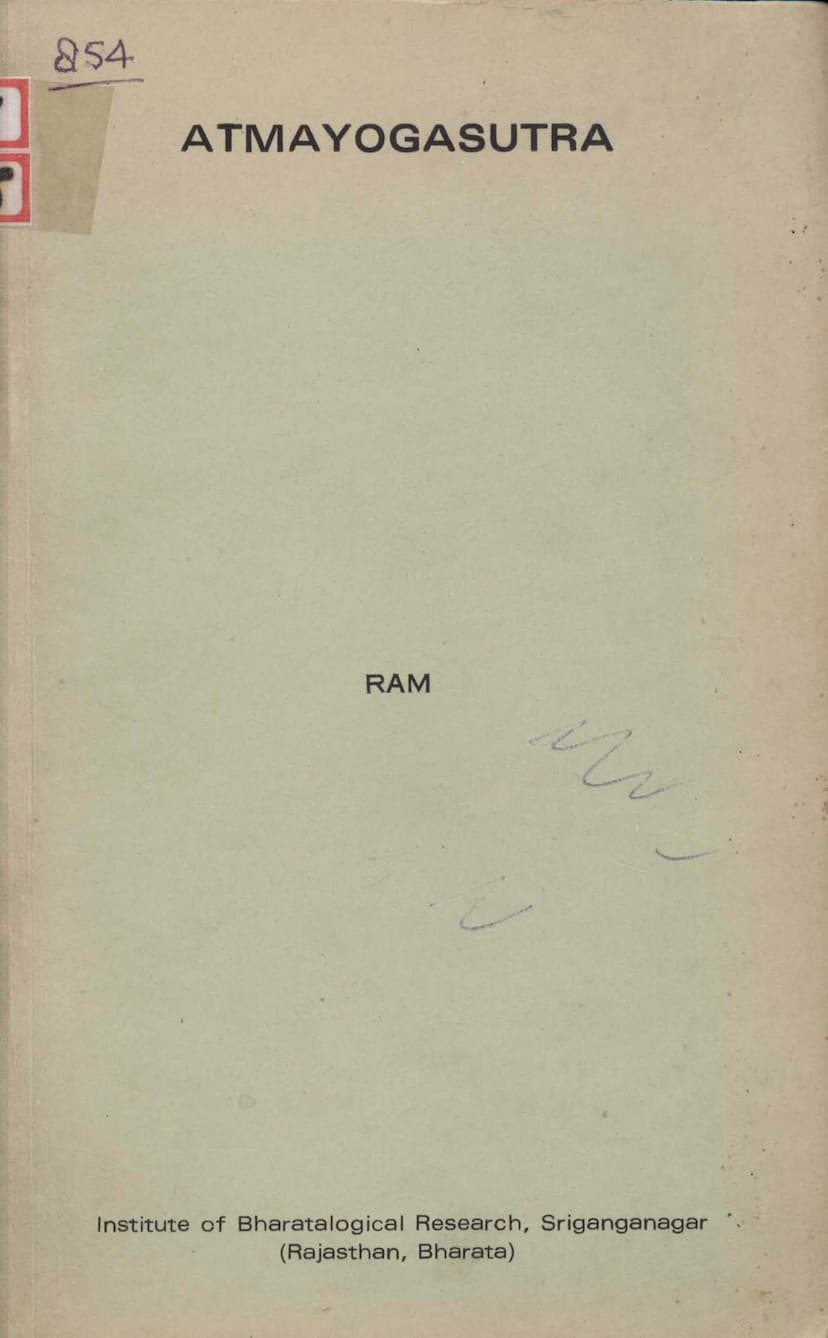Atmayogaasutra
Added to library: September 1, 2025

Summary
"Atmayogasutra" by Ram, published by the Institute of Bharatalogical Research, Sriganganagar, Rajasthan, is a comprehensive work that redefines and re-establishes the original meaning and practice of Yoga, termed here as "Atmayoga" or "Spiriaty." The author critiques the historical degeneration of Yoga into various "degenerated yogas" like Anatmayoga (Matteriaty) and Mithyayoga (Perversity) after 500 AD.
The book posits that the root of "Yoga" signifies "one's own exertion" or "self-effortivity," particularly concerning the Atman (spirit). The traditional Yoga Sutra's definition of "Chittavritti nirodhah" (cessation of the modifications of the mind) is interpreted as "Spirital efforts for the final annihilation of the matteric distractions of the Chitta." The author emphasizes that true Yoga is not about joining but about disjoining matter from spirit.
Core Concepts and Chapters:
The book is structured into seven chapters and several appendices, exploring the following key themes:
-
Chapter I: Atmajnana (Spiri-knowledge): This chapter lays the philosophical groundwork, defining fundamental concepts like:
- Atman: The formless, free, eternal, and ever-moving spirit.
- Anatman: Matter, described as formive, dependent, non-identitial, transformable, motionless, and collectivistic anti-reality.
- Realuum: The ultimate reality, a formless, beginningless, endless, infinite, and ever-moving organic unity of contradictory yet harmoniously coexisting opposites—the Universe and the Anti-universe.
- Realibrium (Samatva): The inherent nature of the Realuum that maintains balance, peace, harmony, and happiness.
- The text introduces new terms like "spatom" (spiritual atom) and "matom" (matteric atom). It explains that life is the organic unity of Atman and Anatman, and their harmony or disharmony leads to health or unhealth, and ultimately, to the cycles of birth and rebirth. The four fundamental natures of the Atman are Samatva (Realibrium), Satya (Truth), Ahimsa (Non-violence), and Svayattata (Freedom). Conversely, the impure Anatman leads to vices like ego, desire, anger, greed, delusion, etc.
-
Chapter II: Atmayoga (Spiriaty): This chapter defines Atmayoga as the highest development of the "Atmamarga" (spiriway), aiming to detach the Anatman from the Atman. It outlines the process:
- Yoking sense organs to the mind, mind to intellect, and intellect to the Atman.
- The goal is to draw spatoms from the universal diafield and thus achieve Atmasiddhi (Self-Attainment).
- The text differentiates between the "deluser" (practicing Anatmayoga) and the "realiser" (practicing Atmayoga).
- It emphasizes the annihilation of "Karmans" (matteric impressions) through right conduct, meditation, and self-struggle.
- The author distinguishes between limited Atmayoga (practiced by the realiser) and total Atmayoga (practiced by the Samnyasin).
-
Chapter III: Anatmayoga (Matteriaty): This chapter describes the path of matteric effortivity, where the Atman is yoked to sense organs, mind, and intellect for increasing bondage to the Anatman, leading to transient material gains, glory, and pleasures. It is seen as the opposite of Atmayoga, leading to perpetual disharmony. The "pure Anatmayoga" aids in annihilating anti-reality ailments and restoring natural reality. The "impure Anatmayoga" (Anatmayoga proper) involves proficiency in "Anatmajnana" and adherence to the "Eightfold-Antiway."
-
Chapter IV: Mithyayoga (Perversity): This chapter critiques various forms of Yoga that are neither pure Atmayoga nor Anatmayoga, deeming them "hybrid progeny" that are barren and delusive. These include Mantrayoga, Hathayoga, Layayoga, Rajayoga/Jnanayoga, Bhaktiyoga, and Karmayoga. The author argues that these were fabricated after 500 AD and represent a "puranaization" and "materialization" of true spiritual practices. He criticizes their materialistic focus and lack of genuine spiritual attainment.
-
Chapter V: Atmadhyana (Spiri-meditation): This chapter details the practices of meditation for the three types of practitioners: realisery entrants, realisers, and right-trustees (Samnyasins).
- It emphasizes the importance of controlling the senses, mind, and intellect through meditation.
- Pranayama (breath-discipline) is presented as a key stage, involving the drawing of spatoms and expulsion of matoms.
- The text advocates meditation on the matterless Atman and suggests various postures and meditation techniques.
- It criticizes the concept of "gurudom" as a materialistic fabrication and asserts that the Atman is its own guru.
- The ultimate goal is Samadhi (residence in realibrium), leading to Jivanmukti (liberation in life).
-
Chapter VI: Atma-Samgharsha (Self-Struggle): This chapter discusses self-struggle as the conscious engagement of the Atman against the Anatman to annihilate it. It outlines the means: the eightfold-way, realisery regulations, Atmajnana, spiritual efforts, and Atmadhyana. The struggle involves checking the inflow of matoms and burning up accumulated Anatmik coatings (karmans, subtle body). This leads to "Atmadarshana" (self-vision), "Vishvadarshana" (universal vision), and "Sattvatvadarshana" (Realuum vision).
-
Chapter VII: Atmasiddhi (Self-Attainment): This chapter defines Atmasiddhi as the fruition of the Atmamarga. Upon attainment, both Atman and Anatman become "only" (kaivalya). The Atman becomes Parmatman (Supreme Atman), while the Anatman's onlyness merges into the material collectivity. A person who attains this while in the mortal body is a Jivanmukta, who remains active for the spiritual upliftment of society until the gross body falls, at which point they become a Siddha.
Key Appendices:
- Appendix I & II (Atmasamkalpa & Anatmasamkalpa): These present "Right Spiresolution" and "Anti-spi-resolution" for individuals, society, and thought, outlining commitments to spiritual or material paths.
- Appendix III (Sadhana ke Atmasamkalpa): Details the "Right Spiresolutions for Realisery" for different stages of practice (entrant, realiser, houser Samnyasin), emphasizing freedom from religious dogma and societal divisions, and dedication to spiritality.
- Appendix IV (Atmayogasutra and Yogasutra): Critically analyzes the traditional Yoga Sutras, arguing for their corruption and bifurcation from an original, united "Samkhya-Yoga." It reinterprets the eight limbs of Yoga from the perspective of Atmayoga, emphasizing its spiritual essence over the matteric interpretations prevalent in later traditions.
- Appendix V & VI (Complete Cycle Infinity and From Micro to Macro): These appendices provide complex diagrams and explanations of the cyclical nature of existence, from the formless Realuum to manifest forms, detailing the interplay of Atman, Anatman, spatoms, and matoms.
In essence, "Atmayogasutra" is a radical reinterpretation of Yoga, aiming to restore its original, non-sectarian, and purely spiritual purpose: the complete disjunction of matter from spirit for the ultimate liberation and self-realization of the individual, society, and thought. It presents a philosophical framework and practical guidelines for achieving this through what it calls "Scientific Spiritality."